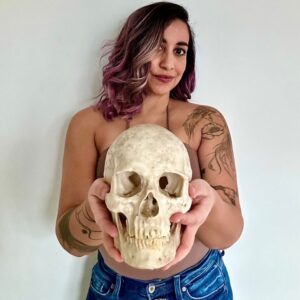Ask The Expert: Paloma Galzi

How can forensic art be used/useful in cold cases?
Forensic art can be useful in a couple different ways when it comes to cold cases. The first, with age progressions. When someone goes missing for years, an updated image of what they might look like today may be useful to show the general public and generate new leads. The second, with facial reconstructions. When remains are recovered, and resources have been exhausted to identify those remains, a last resort situation is a facial reconstruction, to show the public what they may have looked like in life and generate new leads.
What is the most memorable case you’ve helped solve and why is it significant to you?
In my everyday work, I focus on Forensic cases. But back in the day, I did an internship with the museum of Edinburgh and focused my work on archaeological finds. While they were digging the new tramway, they came across nearly 400 remains dating from as far back as the 14th century. I got the privilege to work on a few of them and give some of these Scots their faces back.
In your field is there an advantage to using digital tools to create images?
Accuracy and time saving. When facial reconstructions are created in 3D, we can work with layers to preserve the information from the skull (as opposed to adding clay onto a skull.) For age progressions, the work is usually more realistic, and more precise when done into Photoshop rather than hand drawn.
What do you find rewarding about your profession?
Every time a person is either recovered or identified, and you have worked on that case, you know you have helped a family. You were a part of this, and that keeps me going!
Have you faced any challenges being a woman in your industry?
I have not!
What advice would you give to a young female who aspires to have a career as a forensic artists and what type of education or training does she need?
You’ll need a solid art background in drawing, sculpting, painting, 2D and 3D. I then went on to get a Masters degree in Forensic Facial Imaging at the University of Dundee, presently the only place in the world where this program is offered. To be affiliated or have contacts with law enforcement is always a plus, as most forensic artists are within law enforcement. Know that this field is difficult to get into, but not impossible and do not discourage yourself if this is what you want to do! It took me 3 years to land the job that I have now, and before that I worked as a forensic artists consultant here and there alongside another job to pay the bills. It took a while, but I eventually got a full time job as a forensic artists consultant. And so can you.

Paloma holds a bachelors degree in fine arts from the California College of Arts in San Francisco, USA. She pursued her studies in Scotland and earned a masters degree in Forensic Facial Imaging from the University of Dundee, presently the only place in the world where a full forensic imaging program is offered. After graduation, she was involved with several archaeological projects and forensic cases across the UK. She was also on the database of the National Crime Agency (UK organization), listed as an Expert Adviser in Forensic Imaging Specialist during her time in London. The NCA fights organized crime to strengthen their borders, fights fraud and cybercrime, and protects children and young people from sexual abuse and exploitation. She later interned at The National Center for Missing and Exploited Children (NCMEC) in the US, taught law enforcement officials and presented her work to media and other associations. In 2018, she was hired by the NCMEC as one of four full time forensic artists, working solely on children’s cases across the United States. In this role, she has helped several case recoveries and identifications along the years. Follow Paloma: Instagram & TikTok (@galziforensics) and Twitter (@PalomaJGalzi).
